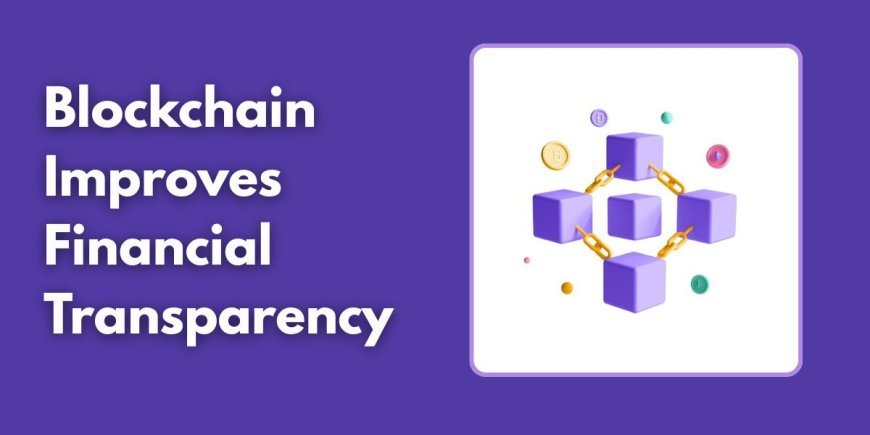How Blockchain Improves Financial Transparency

Blockchain technology has emerged as a powerful tool for transforming the global financial landscape. With its decentralized structure and immutable ledger system, blockchain fosters greater accountability, reduces corruption, and enables open, real-time financial reporting. These advantages are reshaping how governments, institutions, and individuals handle and view financial transactions.
Financial transparency is more than just a buzzword—it’s a necessary step toward building trust in both public and private sectors. Traditional systems often suffer from opaque practices, limited oversight, and human error. Blockchain, on the other hand, offers a built-in mechanism for transparency through its core principles of decentralization, consensus, and immutability.
What Is Financial Transparency?
Financial transparency refers to the availability and accessibility of financial information in a clear, accurate, and timely manner. It’s essential for informed decision-making, investor confidence, and institutional accountability. In sectors like banking, non-profits, and government, lack of transparency can lead to fraud, inefficiency, and misuse of funds.
Blockchain steps in as a game-changer by enabling verifiable digital records that can’t be altered or hidden.
How Blockchain Enables Transparent Financial Systems
1. Decentralized Record-Keeping
In a blockchain network, no single party has complete control over data. Instead, all participants maintain a shared copy of the ledger. This prevents unauthorized changes or concealment of transactions, making it easier to detect and prevent fraud.
This model is particularly beneficial in public finance or charity organizations, where stakeholders demand visibility on how money is allocated and spent.
2. Immutable and Auditable Transactions
Once data is written to the blockchain, it cannot be modified or deleted. Each block contains a cryptographic hash of the previous block, ensuring a permanent and traceable audit trail. This immutability assures investors and regulators that records are authentic and unaltered.
For companies, this means improved compliance and simplified reporting, while auditors can reduce manual verification efforts.
3. Real-Time Visibility
Smart contracts and blockchain-based systems can offer live financial data to stakeholders. Whether it's cross-border payments or government grants, every movement of funds can be monitored in real-time. This is a drastic improvement over traditional systems that often involve delays and manual reconciliation.
However, as convenient as these systems are, sometimes users may face transactional issues. In such cases, concerns like a Crypto.com refund delay may arise when blockchain transactions are pending or under review. Transparency in the blockchain helps users and support teams identify the source of delays more effectively.
Use Cases Demonstrating Blockchain Transparency
Supply Chain Finance
Businesses can use blockchain to track every financial interaction within a supply chain. From product sourcing to payment settlements, stakeholders can verify each transaction, reducing the risk of invoice fraud or double financing.
Government Spending
Several countries are exploring blockchain for budget transparency. By recording government expenditures on a public ledger, citizens can hold officials accountable and track where taxpayer money is going.
Nonprofit Donations
Charitable organizations are adopting blockchain to improve donor confidence. Transparent donation tracking ensures that funds reach the intended beneficiaries without being siphoned off.
Blockchain and User Accountability
One of the unique strengths of blockchain is that it holds all parties accountable. With wallets and addresses linked to every transaction, even pseudonymous users leave a permanent trail. This discourages malicious behavior and encourages ethical financial practices.
If a user encounters suspicious activity on a platform or their account is compromised, having access to a direct crypto.com customer service number is essential. Customer support teams can assist with account recovery, transaction traceability, or initiating refund procedures using blockchain data.
Challenges to Implementation
Despite its benefits, blockchain is not without hurdles:
-
Scalability: Some blockchains struggle to handle large transaction volumes efficiently.
-
Privacy: Public ledgers can raise concerns over data exposure in sensitive financial environments.
-
Integration: Traditional financial systems may require significant upgrades to integrate with blockchain platforms.
Overcoming these challenges will require collaboration between governments, private sectors, and developers to create hybrid solutions that balance transparency with compliance and privacy.
Final Thoughts
Blockchain technology is paving the way for a more transparent and trustworthy financial world. By ensuring that financial transactions are traceable, immutable, and decentralized, it helps reduce fraud, increase accountability, and build greater confidence in financial systems.
While the road to widespread adoption may be complex, the long-term benefits of improved transparency are undeniable. For users and institutions alike, embracing blockchain could mean a more secure and transparent financial future.
What's Your Reaction?






























































